If this seems like a strange topic for me to cover - it is. If you can’t already discern what the topic actually is from the title - you’ll see what I mean. And, of course - why?
Well, when I’m at work, I get bored. When I get bored, I don’t work. Unfortunately, I’m afflicted with that one kind of ADHD in which my mind must be constantly stimulated, at least partially, because if it’s not, I will just straight up zone out and lose myself in lush and elaborate daydreams and fantasies of all manner and stripe. One of my favorite teachers in high school said, This story is basically about you, when we read James Thurber’s The Secret Life of Walter Mitty, and, really - she wasn’t off the mark.
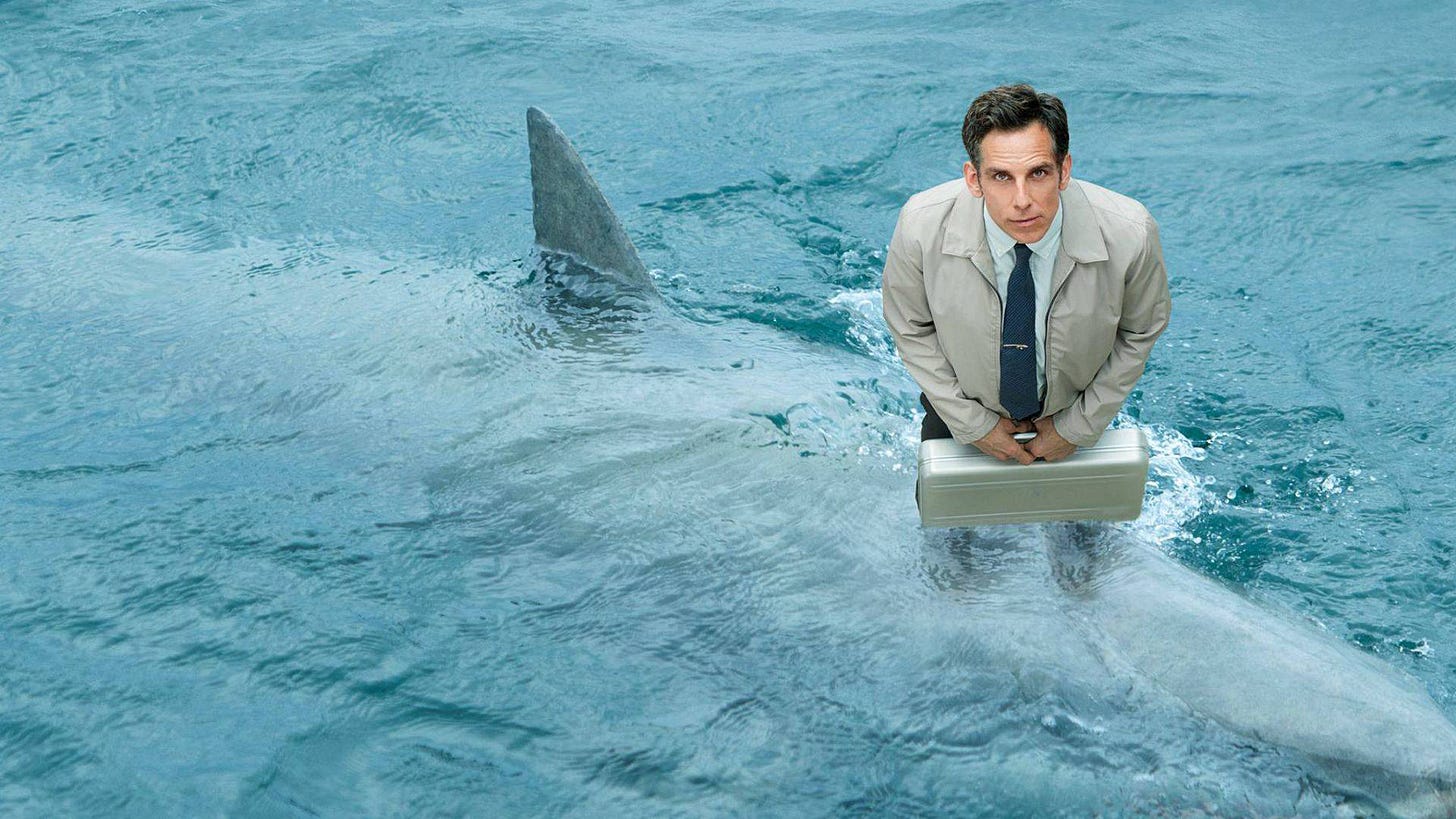
She only knew this because I confided in her my issues focusing, and she, in turn, was one of the only teachers that seemed to understand that, no, really - if I don’t have music playing while I work, that work just wasn’t going to get done, and instead I’d frolick about some candy-colored dreamland in the darkest recesses of my mind while my GPA crashed and burned. This was back in the day where having your little blue iPod mini or Zune or whatever other boot-leg, cheap-ass MP3 players were floating around out there were basically considered to be portable cheating machines, since there was this unfounded fear students would use them to record the answers to tests or something and play them in class while taking said test. Maybe that did happen somewhere out there, but, for the most part, I think that was giving my generation too much credit.
So, now that I’ve gone from a student that struggles to focus on mind-numbing, repetitive, rote and unengaging tasks in school to an adult that struggles to focus on mind-numbing, repetitive, rote and unengaging tasks at work, I rely pretty heavily on a constant stream of internet noise throughout the day in order to keep the irascible, impatient, and energetic half of my mind occupied so the more orderly, cerebral, and sedate side can actually perform work-related duties. Music, podcasts, YouTube videos, even television shows, if I can stream them - if it’ll keep my inner iPad baby pacified and quiet and prevent it from experiencing a chimp-like meltdown, it’s gonna get played. It’s not ideal, but it works. I mean, this condition has basically almost ruined my life multiple times over, cost me relationships, careers, and opportunities that will never present themselves again, but, hey - it is what it is, you know?
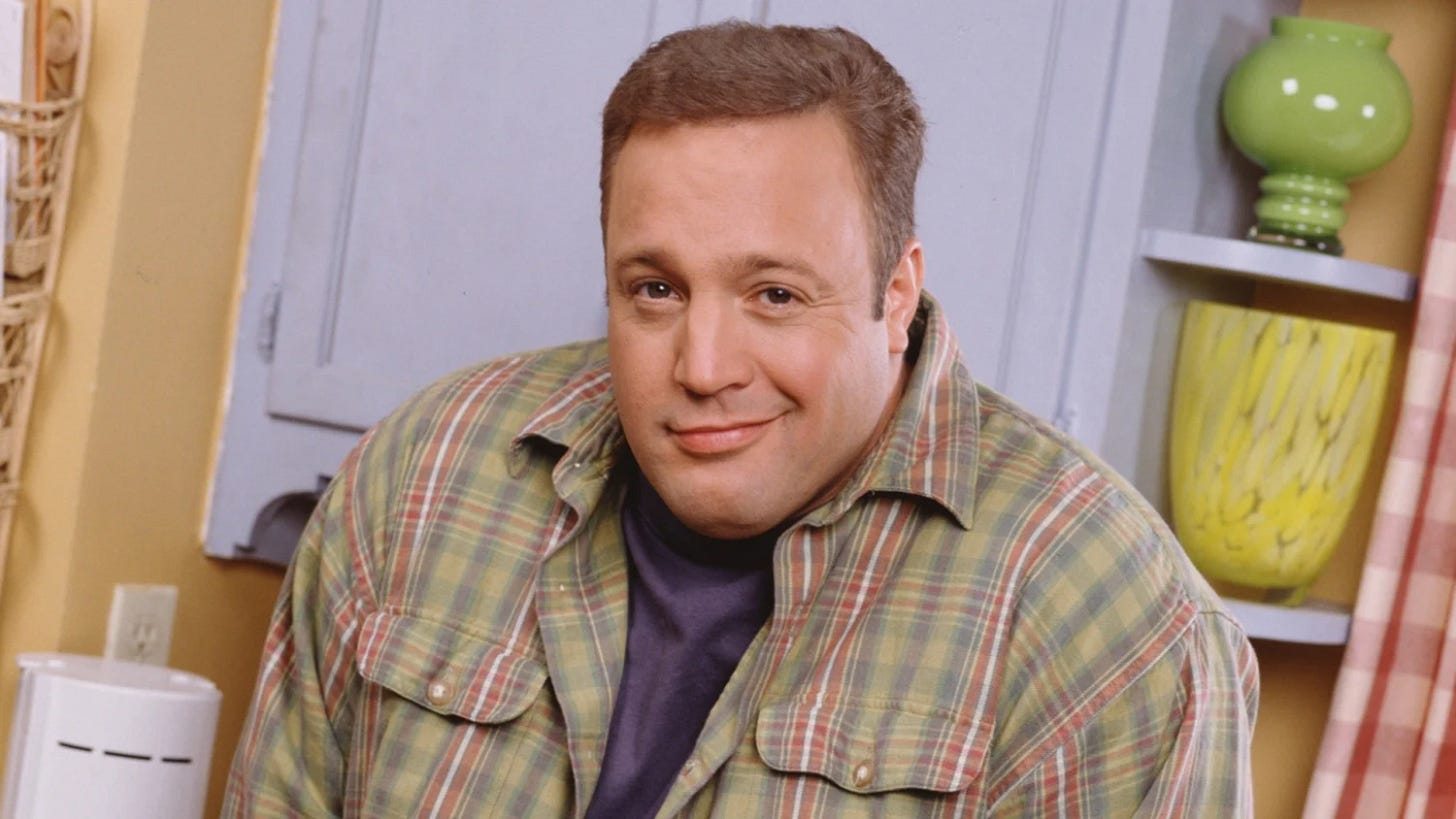
This is all to say that there's a surprising dearth of content out there on the internet. For a place that supposedly contains the culmination of all human knowledge, it feels awfully… small, these days. Insular. Incestuous, almost. So much of what you see is the same shit, repackaged and recycled and slathered in a thin coat of paint with the barest minimum effort put into it, or people just talking about the same mile-wide, surface-deep material ad nauseum, never really adding anything to the discussion or having any original thoughts or spectulation to add to to the topic.
For instance, I enjoy the paranormal, the occult, and other such adjacent topics, yes? I mean, I've written about as much. Well, I can safely say that I've exhausted pretty much every podcast on the topic, and I can assure you that 99% of them are one of three things: mediocre, repetitive, or both. And, when I say repetitive, I mean that they discuss the same topics to death. Like, yeah, I get it - new cryptids aren't exactly popping up in spades these days like they used to (sadly), and, even if you are able to articulate a complete sentence, you will, out of necessity, have to touch on some of the big boys1 in the field or popular cases at some point. If you start a paranormal podcast, you're basically obligated to do a multi-part series on Mothman, which, at the this point, has been so thoroughly talked over that I'm pretty sure illiterate bushmen in Namibia who’ve never even seen a computer screen could tell you the story down to the most minute detail just through the Hundredth Monkey Effect alone. It also created this weird sub-culture of obsessive cryptid fans that like to imagine the Chupacabra and Mothman and Greys as cutesy little goofballs and goobers which has turned all cryptids of any real notoriety into a member of some sort of comically schmaltzy pantheon of doe-eyed oomfies akin to the Care Bears, which, I mean… I kind of get. It can be fun and cute, but at the same time - guys. C'mon. These are probably, like, demons. From Hell.
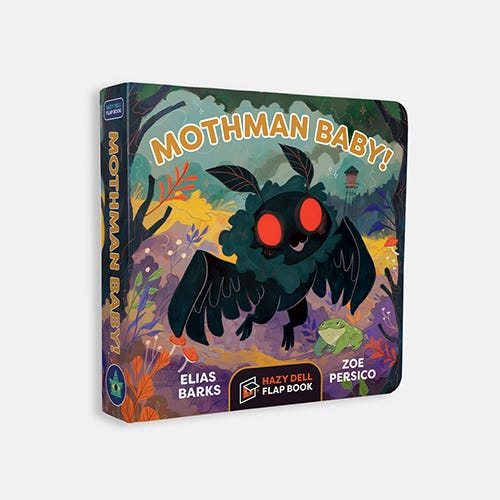
The same goes for True Crime. I find the lurid and explosive popularity of the genre to be voyeuristic at best, distasteful most often, and outright deviant at worst, but, I won't lie - I have been known to indulge. Even more than the field of paranormal and occult podcasts, this genre demonstrates Skinner's Law starkly, plainly, and unflatteringly. If the proliferation of forty-something year old unmarried winos aren't caking their faces in toxic cosmetics while talking about how some poor twelve year old girl was murdered by a sociopath in gruesome detail the same way they discusses celebrity gossip, or hormonal teenage girls with no sense drawing yaoi fanart of the Columbine shooters doesn't give that game away, the recent drama surrounding the murder of four college students in Moscow, Idaho should. Armchair, amateur sleuths from reddit and TikTok nearly derailed the case by driving all the way to the town so they could play Columbo, when, in reality, they would make Inspector fucking Gadget look like Hercule Poirot.
Then again, I believe I may be disrespecting the good Inspector, since even he would understand the concept of preserving a crime scene, which, for all the True Crime content these TikTok hawkshaws consume, is something they apparently still struggle to grasp.
He also had the single most banger theme song to any cartoon from yesteryear I can recall.
Point is, it really doesn't take that long for me to exhaust the one percent of content pertinent to topics I do find enthralling, and it takes only a little more time to run through the mediocre content I can stomach before I'm left listening to some mouth-breathing idiot reading off the Wikipedia page about Skinwalker Ranch or yet another Jeffrey Dahmer retrospective, in which he’s regarded as some sort of tragic, misunderstood rock star who had a career rather than a sociopathic subhuman. Even the content creators that make podcasts and videos that I want to watch or listen to have responsibilities other than generating entertainment to keep me sane at work, which means that new material is released in an unreliable drip-feed at best and a steady drought at worst. So, sometimes, if I'm not feeling like listening to the entire discography of the Electric Light Orchestra, or re-educating myself on obscure retro video game anti-piracy measures, or just getting back to the classics and watching a two hour long breakdown of the Patterson-Gimlin footage, I have to venture into the murky unknown.
Often, this involves listening to things I really don't care about. If you've ever wondered why I know so much about the ongoing slow-motion collapse of the House of Mouse and the continued demolition of legacy franchises like Marvel and Star Wars despite constantly professing my apathy towards them, well, it's because Disney and its subsidiaries are so miserably inept that their fuck-ups have become as predictable as the setting and rising of the sun, and, if nothing else, there's always some bullshit fresh from the puckered sphincter of the Happiest Place on Earth to keep me distracted for an hour in the morning. As I've said just about every time anything Disney happens to come up, there's an entire cottage industry of YouTubers who do nothing but kvetch about Disney, Star Wars, Marvel, or all three, along with other “woke movies”; given that their rent is literally paid by this content and the angry nerds who pay them monthly jizya to make it, their uploads are about as consistent and certain as death and taxes. After all, if they’re to be believed, there’s no shortage of LucasFilm insiders that, apparently, would risk violating numerous NDA's and terminating their cushy studio jobs just to leak internal secrets to some terminally online dork on YouTube and air all of Kathleen Kennedy’s dirty laundry. Very convenient for said terminally online dorks there is a steady-stream of Disney defectors like that.

But, like Alice, I also end up, bleary-eyed and foolishly, tripping over my own feet and plummeting headfirst down rabbitholes that lead to some very strange, very inexplicable, and sometimes disturbing places, thanks to the YouTube “Recommended” algorithm, which, to continue to metaphor, is my own personal white rabbit that I chase after like a moron. For every three-hour video essay about the artistry and thematic content of a movie I've never seen or a video game I've never played, or an hour long rant about drama in some community I'm not a part of caused by people I don't know, or a breakdown of some overlooked yet mildly interesting historical event, I'm exposed to a channel with maybe a hundred subscribers at most and many, many more videos pertaining to subjects that simply defy belief. Just last week, I was a bit taken aback to have stumbled blindly across this channel, in which a grown man who has clearly dedicated his life to collecting novelty singing animatronics, talking toys, and other cheap tat regularly posts hour-plus long videos about his extensive collection of singing “Frogz”, which seems to be rapidly evolving from a “collection” to a hoard.
Now, I'm not posting this to make fun of the guy, who I think it could be safely said is a bit… eccentric, to put it mildly, but more to just show that there are some bizarre fucking people and places on YouTube that make Alice's Wonderland look like a haven of logic and reason by comparison. Like, how does someone end up collecting “Frogz”, of all things? What drives them to share this extensive collection with the world? What audience is this for? His videos don't crack more than two hundred views on average, but does that mean that, somewhere, there's a very small but fervently passionate fanbase of Frogz lovers? Am I the weird one for taking such voyeuristic in the deranged obsession of a madman2? Finding content like this leaves me feeling like a Lovecraft protagonist - as if I've glimpsed a brief flash of some great and terrible thing of otherworldly affect that far exceeds all reason and comprehension and quite possibly may drive me mad should I stare at it for too long.

Which, finally, brings me to the subject at hand this lovely day - another rabbit hole that I was wholly unaware of, and nearly broke my ankle tripping over when it made itself apparent to me. And this rabbit hole - if you couldn't already tell by the name - is none other than that of the American Girl dolls.
Yes - you know them. I know you do. You've seen them before. You might have even played with them, or maybe you had a sister or cousin that did, but, somehow, some way, we all seem to know about these chubby-armed, buck-toothed, exorbitantly-priced line of diverse dolls. As it turns out, the line has a decently sized and very passionate fan-base of adult collectors and a healthy following among the actual target demographic of little girls, the former of whom like to take pictures of their extensive collection of their plastic, glass-eyed gals, and, much like anime fans editing footage of their favorite series and setting it to music, a not insubstantial amount of American Girl fanatics take their dolls… and record music videos with them.
Go ahead. Give it a watch. It's… certainly something. And, look at the view count. Seriously. I won't ruin the surprise.
Seen it?
Yeah. Kinda fuckin’ blows your mind, doesn't it?
Clearly, there's an audience this sort of thing, which, again - I wouldn't have guessed. It seems that the corporate masterminds behind the American Girl line cued into this absurdist nightmare of a trend and decided to dip their toes into the genre and make animated American Girl Music Videos - AGMVs, if you want to save yourself a mouthful - with assets taken from photos of the dolls instead of actually using dolls themselves and, ah… you know what? I'll let the end product speak for itself.
There is… something deeply unpleasant and unnerving about the way this is animated. The awful little song doesn't make it any more endearing, either. Something of it smacks of the sinister, just beneath the glitzy pink veneer, but I think that just may be my inner schizoid-cynic at play. I'd say that this is, as the kids would say, plain “cringe”, but, again, the view count of millions suggests otherwise.
But, we're not here to talk about silly music videos. After watching several of these in gobsmacked disbelief, going through one after the other out of sheer morbid curiosity, I found myself watching some retrospective videos on the toy line itself, diving deeply in-depth into the history behind it and its evolution from a humble collection of three dolls to a veritable empire; an evolution that I was surprised to see played out like a dark reflection of the progression - or perhaps regression - of American culture into modernity. It would only make sense - the American Girl line was created to showcase and celebrate American history and present it in a palatable way to young girls by showing the past through the eyes of relatable characters that were of the same age and gender as the target audience. And make boatloads of cash, too, but that should go without saying.
This mission statement to educate and entertain, of course, would change over time, and, as it did… well, I began to wonder more and more as I poured over lost and esoteric volumes of cursed American Girl lore… if the toy line was always rooted in American history and culture, was it destined to decay, wither, warp, and distort in similar ways? If the American Girl dolls were designed to be emblematic of their time, what would the American Girl of today look like?
Kidding. I'm kidding. But… we'll get to that, because, as always… before that story… I have to tell you this story.
Now, unlike Star Wars or Digimon, which I've talked about before, my history with the American Girl series is limited, to be generous. This really should be unsurprising, but, I'm sure some of you aren shocked, and were probably laboring under the delusion that I was spending my time lovingly braiding my American Girl’s hair while I excitedly relayed to her all the hot new Bionicle lore that dropped in the latest installment of the book franchise. I hate to disappoint, but, truth be told, I did not own an American Girl doll.
I also remember there was an entire store dedicated to American Girl merchandise at the Dallas Galleria I’ve stepped into once or twice out of curiosity. I don’t remember much about it other than thinking, Huh. This certainly is a thing, and, Wow, I didn’t know they had this many different dolls. They’ve got ten of these places across the U.S., and, given that only one closed during COVID - and even then, just relocated to a different place - and all seem to be weahtering the continued decline of the American shopping mall just fine, I think that speaks to the health of the franchise as a whole. We’ll touch on the stores later, though.

Now, I was an avid reader as a youth, and tore through books at a pace that I wish I could maintain today. It probably helped these books were, like, maybe seventy pages long and written with a total vocabulary of two-hundred words, but that's neither here nor there. The point is, I would read whatever I could get my hands on, and, much like today, once I exhausted a supply of books about subjects and stories that actually interested me, I'd be forced to branch out a bit and dive into foreign territory. Since I wasn't about to crack open Goosebumps books for reasons I've already elaborated on, which were a ubiquitous staple of bookshelves throughout elementary school classrooms at the time, I instead turned to a less… ghoulish and more girlish alternative.
All of the original American Girl dolls had a series of books that were published over time after their release which elaborated upon their lives, their characters, and the greater American society around them at the time. Though not nearly as monolithic a presence as Goosebumps, the American Girl books were popular in their own right, and, due to their historical and educational cant, were very common sights in classrooms and easy to acquire. So, even though they were American Girl books, I was an equal-opportunity reader, and I was willing to give these girls a fair shake to humor me. As explained before, I couldn’t afford to be particularly prejudiced.
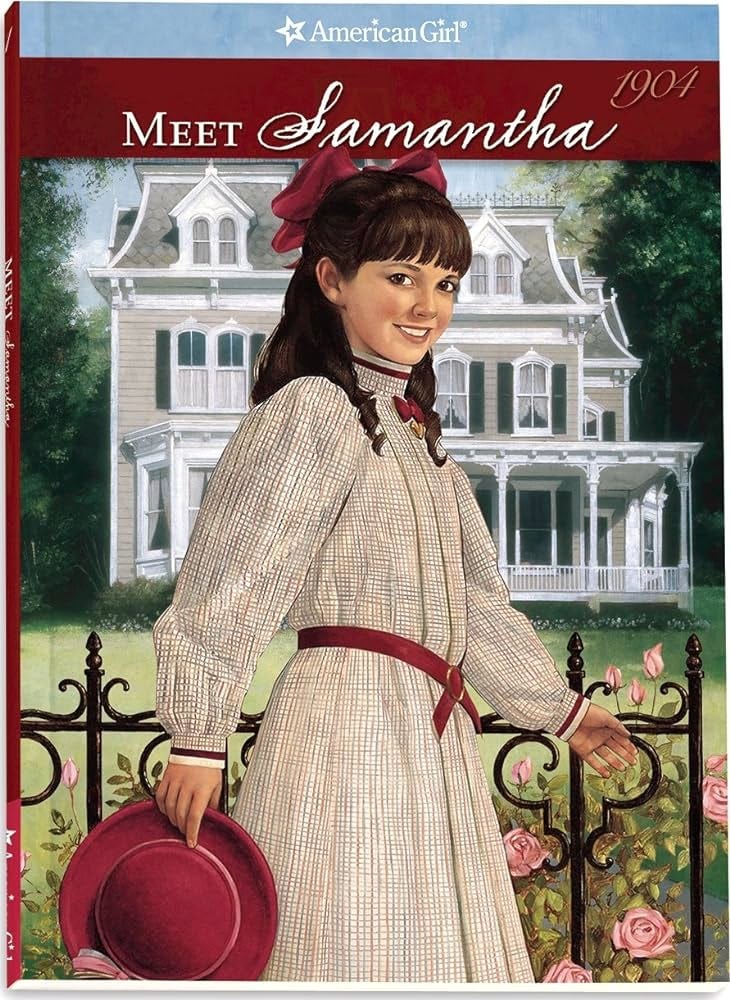
They were fine. I remember liking them well enough. At least, as much as I could like something that was about normal girls in a very mundane setting, since there were less monsters, dragons, sword-toting knights, and space wizards featured than in my usual fare. As a history buff from a young age, I remember enjoying the historical aspects of the setting, which were usually belabored and detailed as a means of educating the reader in the same way you might slip a pill into a piece of deli meat for your dog to trick them into eating it. Even though the protagonists were young girls, too, there was nothing objectionable or unpalatable about the stories for a young boy, which, for a long time, left me with the impression that girls in the past were generally smarter, more rational, and made more sense than their modern counterparts. I’d say that notion was dispelled over time, and, for a while, I thought it was, but these days I’m pretty sure men and women in ye olden days were both generally smarter, more rational, and made more sense than their modern counterparts.
The American Girls themselves, as protagonists, were also perfectly serviceable as characters. The books, despite the name, were not really as heavily gender-coded as so many other kid’s material are, and, by that, I mean that they weren’t drenched in stereotypical feminine iconography that a young boy would find unpalatable - no glitter, no pink unicorns, no talk about cosmetics, that kind of stuff. The toy line always had this emphasis that the characters were relatable to modern girls by virtue of just being girls, and maybe that’s true for the dolls that I wasn’t playing with, but, when it came to the characters in the books, I found them relatable by virtue of the fact that both they and I were kids.
They were nine. I was nine. As it turns out, being nine is a universal experience not exclusive to any one gender. I'm pretty sure I could have cracked open a book about a French peasant girl from the 14th century and I could have related to her. I mean, yeah, maybe my parents weren't dying of the Black Plague, leaving me to tend to the farm by my lonesome like little Jeanne-Cecile Demoulins, but I did have to do homework instead of watch Spongebob some nights, and that was almost as upsetting, so I could definitely empathize with her hardship.
Out of the line-up, my personal favorite was Molly.
I'd like to say that it was because her era was that of World War II and war is cool and based, but I ain't gonna lie to you - even when I was eight, I had a type, and I knew what it was.
Maybe it's the dorky twin-tails or the John Lennon-esque specs, but something tells me that if Molly had been around in 2004 instead of 1944, she would have been sitting under the playground with me and playing Pokemon Ruby and Sapphire on a Gameboy Advance and watching Sailor Moon after school instead of… chain-smoking cigarettes or doing the Charleston or whatever the fuck kids in 1944 did.
I do remember that Molly’s entire schtick was that her father was over in Europe participating in the Second Great Brother War and that, even though she was a spastic, hyperactive, gawky kid that got into bitch-fits with her siblings all the time, she had delusions of grandeur about being a movie star or a professional dancer and was constantly pulling stunts to try and get people to pay attention to her. The official site describes her as “fiesty”, but I think that’s just a child-friendly and amicable way of saying histrionic.
Again - I always have had a type. For better or worse.3
I also distinctly remember the book Samantha Learns a Lesson, about the girl from 1904, in which the lesson she learns is that the Irish are, to her shock, actual people. Not white people, per say, but people all the same4. The official site describes her as “generous”, which really is accurate since she both befriends and educates a literal poor Hibernian street urchin/child laborer and selflessly teaches her how to behave like a member of civilized society rather than a Celtic barbarian. Kind of like Pygmalion, but if it was written for eight year old girls.
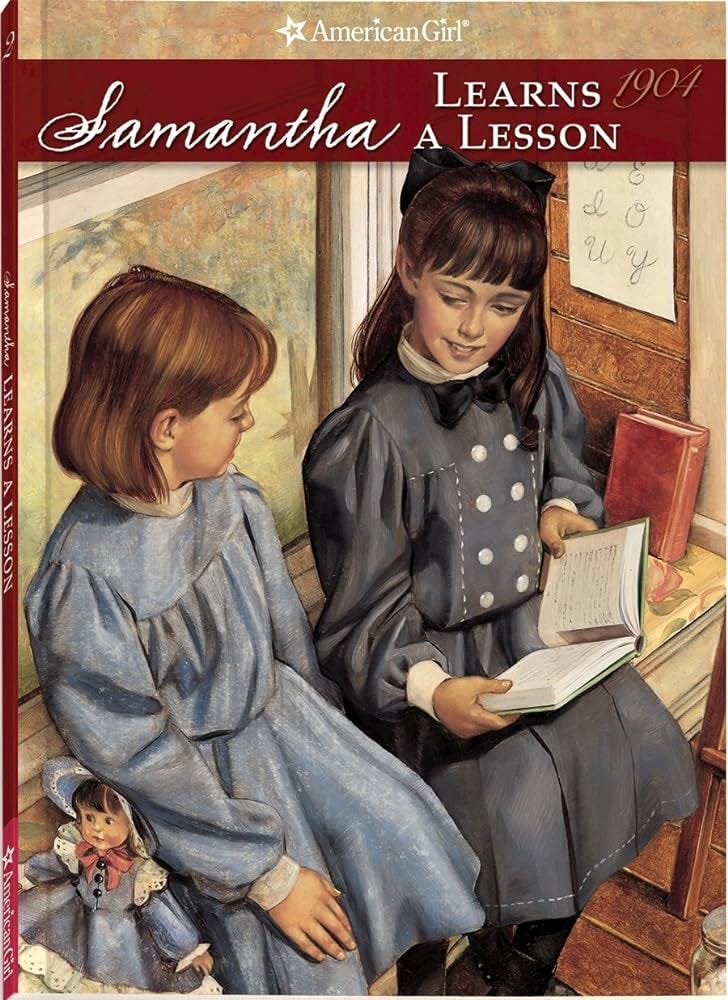
There was also Kirsten, who I don’t remember much about except that she was a Swedish immigrant child to the rough, rugged, hardscrabble frontier of… Minnesota.
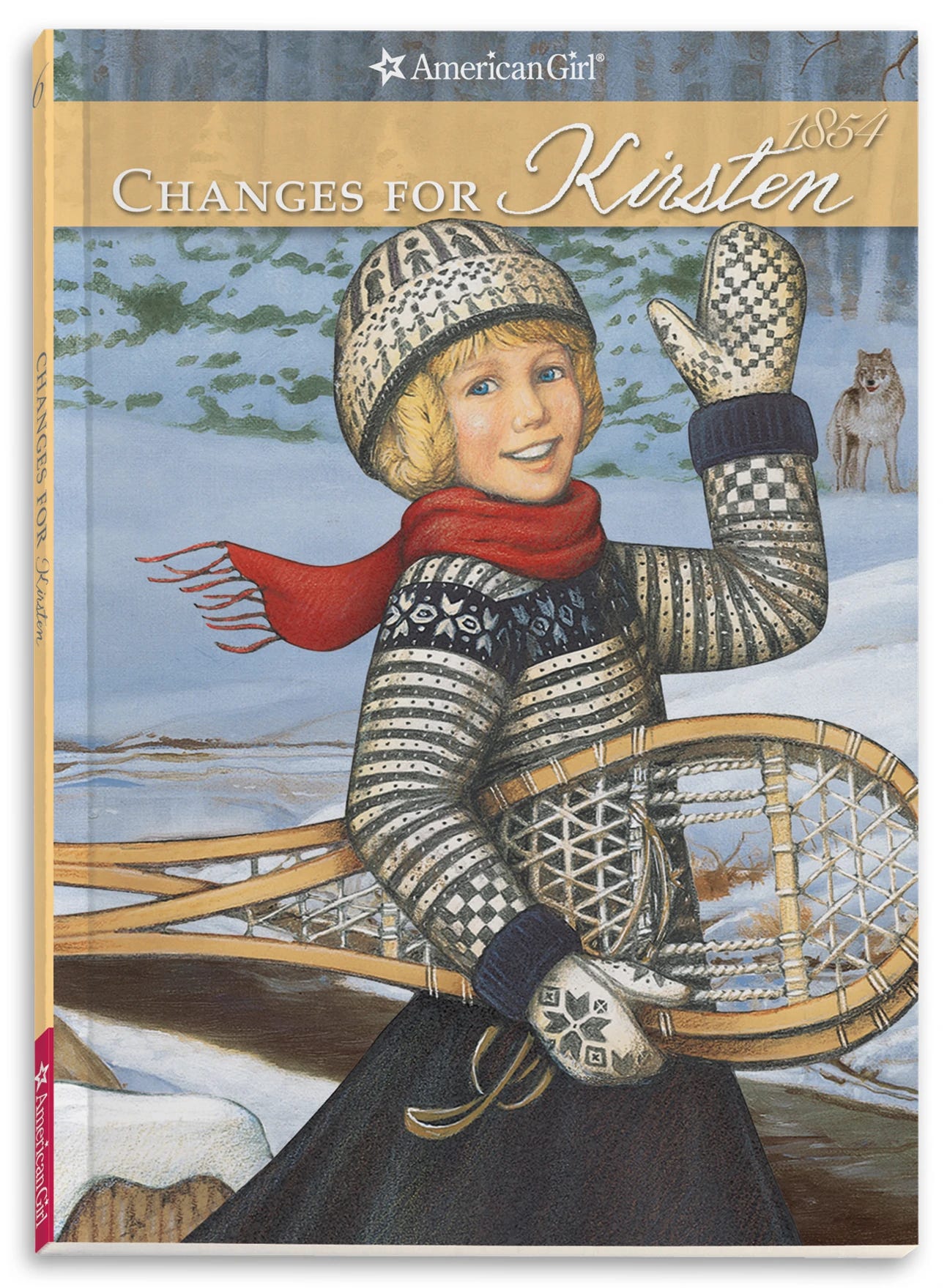
Well, at the time, Minnesota was the frontier. Back in 1854, Minneapolis was probably only marginally less dangerous than it is today! Ba-zing! You know today’s American Girl representative from Minneapolis would look more like Ihlan Omar than Kirsten, here. She’s also Swedish, so, uh… meatballs, Ikea, ABBA, vikings, I dunno, man, pick whatever stereotype about the Swedes and make your own joke, here.
In all seriousness, though, there is something about Kirsten that makes me think her stories would be decried as white supremacy if she’d debuted today, if only because it seems like acknowledging white settlers and pioneers existed, let alone, y’know, settled seems like something that would be unequivocally racist by 2023 metrics. It doesn’t help that she’s a blonde-haired, blue-eyed Scandinavian. Possibly Hyperborean. Yeah, that’s right - when I was at the Dallas American Girl store, I managed to finagle my way into accessing the vault of forbidden American Girl tomes of lore and found the long-lost novel, Kirsten Goes Home. They don’t want you to know that Kirsten’s original home really looks like this:
And if you think that’s crazy, just wait ‘til I manage to publish samizdat copies of the series about the nine year old immigrant from Tartaria, Orfina, and her wild adventures at the World’s Columbian Exposition of 1893 in Saint Louis.
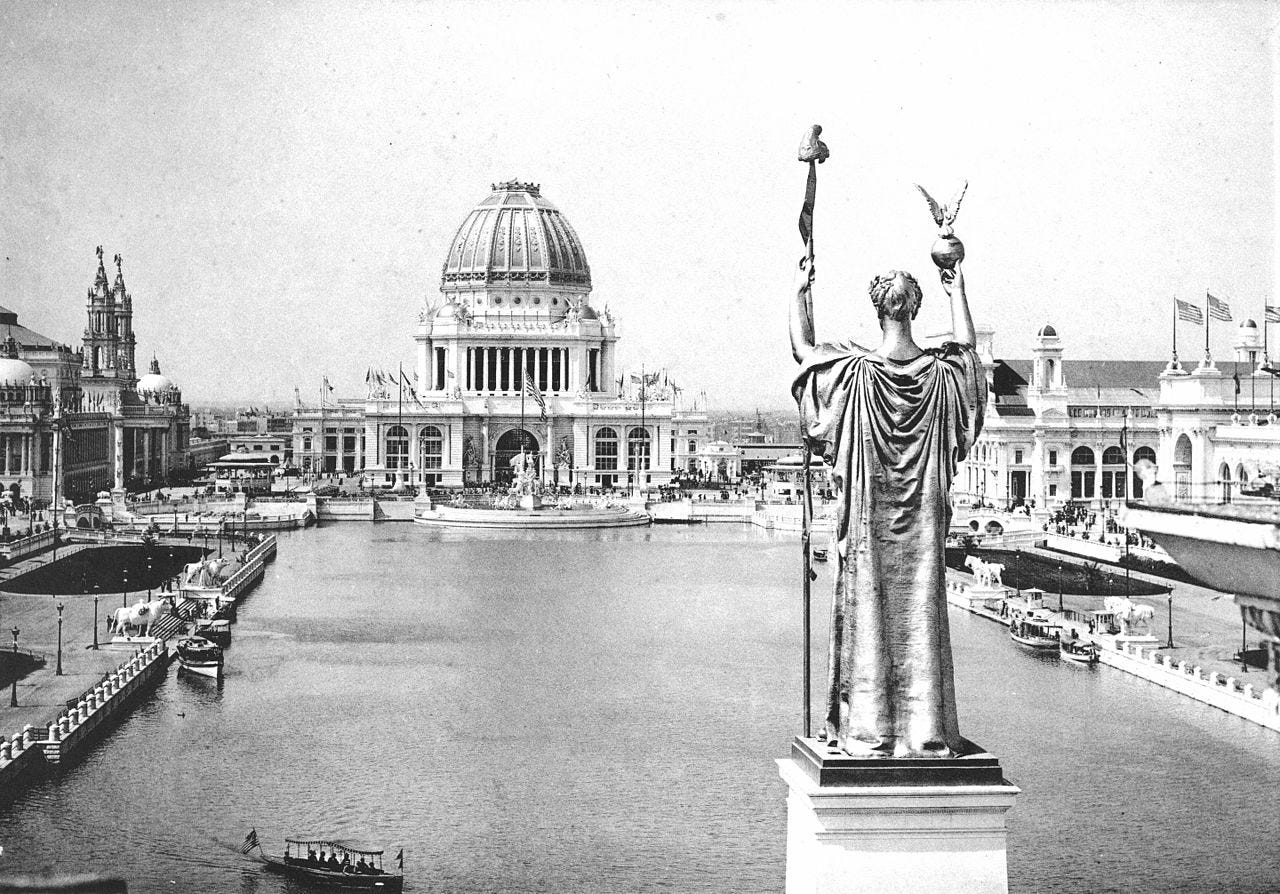
But y’all ain’t ready for that discussion, yet.
Now, this seems like as good a place as any to briefly cover the history of the dolls. Or, at least, the history of the dolls as they would want you to believe… which begins with a woman called Pleasant Rowland of Chicago, who, between her name and appearance, may be the single most distilled essence of American grandmother I’ve ever seen.
Miss Rowland came from a well-to-do family in the Chicago suburbs and spent most of her adulthood engaged in a variety of careers, spending time as a news anchor, school teacher, and textbook writer, among other endeavors. It was in education that she found a calling, and, while working as an educator, came to the epiphany that children learned better when they were so engaged with the topic that they didn’t even know they were learning than they did when they were forced to read reams of dry, uninteresting text out of a pictureless book. Half-a-century later, this discovery has gone largely unacknowledged by the American public school system, though, not for a lack of trying on Miss Rowland’s part. She started several programs that are still in circulation today, most notably one called Superkids Reading that’s supposed to be entertaining, educational, and effective.
How effective or entertaining it really is, I can’t say, but I’ll give her the benefit of the doubt and say her heart was in the right place. Now, Miss Rowland, being a bit of a history buff herself, took a trip down to Williamsburg, Virginia in the year 1985. For those unaware, Williamsburg served as the capital of the Virginia Colony in the lead-up to the Revolutionary War, and today boasts what is called a living history museum, which is a part of town which has been meticulously recreated (or, in some cases, they restored old buildings) to resemble what it might have looked like in the Colonial era, replete with gaggles of costumed re-enactors in period-appropriate wear that will talk to you in period-appropriate dialect and accent and absolutely insist they have no idea what a telephone is if you ask them. You aren’t even able to drive a car through this part of town, nor do any of the buildings have visible electricity running through them (though, thankfully, they do have indoor plumbing). It’s a place that I went with my father many years ago that I enjoyed greatly, myself. Well worth a trip, if you ever find yourself down in that part of the country.
Just for the record, it was also the first and last place I ever saw a ghost with my own two eyes, but that’s a story for another time.
Anyways, Miss Rowland was so tickled by the experience that she got to thinking. Maybe - just maybe - they might be able to get little girls interested in history better if they could, in a way, see themselves in it by living vicariously through girls that would have lived through those times?
She also may or may not have noticed that there were a whole lot of baby dolls, a whole lot of Barbie dolls, but there was a conspicuous absence of dolls that were represented girls that were, y’know, actually of the age that played with dolls. And in that absence… Miss Rowland smelled an opportunity.
So, synthesizing the two concepts, in 19865, she founded her own company - The Pleasant Company, which I decide if is simple and uncreative name or actually ingenious - and American girls were thusly introduced to the first three American Girls; Samantha Parkington, Kirsten Larsen, and Molly McIntire. Much like My Little Pony,the concept was met with skepticism by industry veterans and investors, but Miss Rowland’s suspicions bore fruit - by the second year of the run, American Girls raked in a rough total of seven million dollars, which in Biden’s worthless funny money of 2023, would be just a hundred large ones short of nineteen million dollars, and in only two short years after launch had more than tripled profits, bringing up sales to thirty million dollars ($74 million in Biden-bucks, for those curious). This brought them to the position of the second most popular doll in the toy market, behind the one, the only, the behemoth, the big bitch herself:
For comparison’s sake, in 1987, the Barbie line was only pulling in $437 million… which, apparently, was an off year for the Woman in Pink. If it sounds as if Barbie’s four-hundred some odd big ones versus the American Girl’s humble earnings of seven mil sounds a bit lop-sided… well, it is. But, it makes sense if you take into account that Barbie had been dominating the doll market since her debut in ‘59, which gave her a solid twenty-seven year head start. But, the American Girl line, despite being a nominal competitor to Barbie, also really… wasn’t?
I mean this with the utmost respect to Miss Barbara Millicent Roberts6, but… she’s cheap. Now, now - I’m not accusing Barbie of anything unsavory. She is, after all, more credentialed and accomplished than I’ll ever be, what with her multiple medical degrees, pilot’s license, career as a movie star, and tenure as a sitting politician.
But, back in 1986, the average Barbie doll would run a little girl about twelve bucks. The average daughter of any middle class family would have been able to scrimp and save enough pocket change to get herself a Barbie, as well as Ken to keep her company, and, uh… P.J.?
I can’t tell if P.J. is Barbie’s younger sister or a third wheel, but, whatever the case is, they have fun doing things together. Apparently. And, if a middle-class little girl could expect to get a Malibu Dreamhouse for Barbie to lounge in or a pink VW Beetle for P.J. to get a DUI in for Christmas or birthdays, even girls coming from families of considerably less means could reasonably get a Barbie in her stocking, at the very least. She was easily accessible. Just about anyone could get a piece of Barbie.
But Samantha Parkington? Yeah. No. She was rich, bitch! Just say that last name - Parkington. Doesn’t it just sound dignified? Even though she was an orphan, she was adopted by her grandmother, who was a woman of high society. If you think Samantha was going to was about to waste her valuable time with the poors… well, you don’t know Samantha very well.
At launch in 1986, to court Samantha’s company would have cost you sixty-eight dollars, which came bundled with a paper-back copy of her first book. If you wanted the hardcover edition, that was gonna be seventy-five dollars. Again, to adjust for inflation, if you were a little girl who wanted to be friends with Samantha, that was going to cost Daddy dearest $190.49. At least.
And, if you think middle-class Molly and dirt-farmer Kirsten were any cheaper… yeah, no.
Each girl had an entire wardrobe worth of clothes, scads of accessories, and other ancillary material that tacked on additional expenses, if you wanted to complete the collection. Just to make sure that Molly’s closet was stocked or Kirsten had every outfit necessary to celebrate obscure Swedish cultural festival, you were looking at a significant investment. This is to say nothing of the fact that new material was regularly being released for each girl as more and more books featuring their stories were released. It got to the point that there was even a Best Friends line, where each of the girl’s “best friends” were released as companion dolls. You don’t want Samantha to be lonely, do you? Well, you’d better pony up the cash to get her Irish wench - no, maidservant - no, best friend, Nellie O’Malley. Oh, and, yes: she maybe Samantha’s friend, but make no mistake, she’s every bit as expensive.
And, this is a bit of an aside, but every piece of art I can find of Nellie and Samantha is just… well, look at it.
I get this is supposed to be an easy way of introducing children to the uncomfortable concept of class and racial discrimination in the Progressive-era of America, but, like… just look at her original portrait compared to Samantha’s.

Something about this miserable, dirt-poor child laborer who everyone is openly racist against for the crime of being Irish and Catholic riding the coattails of a sheltered Anglo-American protestant girl of wealth is supposed to be an uplifting story about charity, generosity, and a statement against prejudice, but, like, rather than give her a story of her own, they just tack her on as the token poor for Samantha to tote around… it tickles me. Ironically, these days, Nellie’s doll fetches a significantly higher price on the second hand market than Samantha does, due to being produced in much lower numbers, so…
As the Irish say - God loves a trier.
Anyways, back to the haves and have-nots, this exclusivity was part of the American Girl line’s allure. These weren’t your average fashion dolls. If the average Barbie was a Hyundai econobox, Samantha was a Maserati. They were basically the little girl parallel to waking up and finding a Nintendo 64 under the tree, both in price, the numerous accessories that could be bought for it, and the longevity you were meant to get out of it7; these were not toys that were designed to be played with for a week after Christmas and promptly forgotten about, just like they weren’t babies that you took care of, nor were they one of Barbie’s cadre of empowered adult women that were intended to be an aspirational figure8. An American Girl? She was your friend. She was something special, and she was priced like it. Much of what I read and heard while doing research was that the original American Girl dolls were very well made. They felt like the luxury items they were made to be - they had weight, well-crafted clothes, soft bodies, and had a presence, as opposed to the cheap, plastic, light-weight, and, in a way, disposable Barbie doll. This could even be seen in the marketing. In no ad do you ever see a girl with more than one doll.
Yes, you see plenty of groups of friends, but each girl has one doll. Continually, I read from women who grew up with these dolls in their hey-day in the late 90’s and early Oughts, you never really expected to get more than one of the American Girl. You picked one, and that was your girl. It was ride-or-die. Maybe you got another doll eventually, and, they all say, Yeah, there’s probably a girl out there who’s the daughter of a gajillionaire who got to own every single doll in the line, but, for the most part, the message seems simple - you got to read about all the girls, you got to see all their cool accessories and pretty dresses, but you got one. They weren’t just a doll - they were a friend. I am not kidding you, at the boutique at the American Girl store, girls can go and get they hair did, as some demographics would say… and their doll could get they hair did, too. These dolls were meant to be doted on and spoiled like they were real fucking people. The fans identify as Molly girls or Samantha girls, and, they may like all the different girls, they all had the one that was theirs. But, we’ll come back to that in a second.
You couldn’t even buy the American Girl dolls in stores. At first, they were mail-order exclusives found in the Pleasant Company catalogue. Even when they moved to store shelves, most of the accessories, additional clothes, and even some of the dolls themselves remained exclusively sold through the American Girl catalogue, which many, many people seem to fondly remember reading as a child.
These catalogues were more than just glorified sales platforms - though, first and foremost, they definitely were made to milk more money from little girls. Or, more aptly, their parents. These magazines packed with various goodies for readers, including short-stories, recipes, craft ideas, articles about history that related to the girls, and such things. The recipes in particular seem to be fondly remembered by the former readership, who recall trying to make them with their parents in the long-ago past, which, really is kind of sweet. Personally, I was more of a Lego Magazine and Nintendo Power kid, but, I understand the appeal. Kids these days will never know the rush of endorphins you got when you came home from school and saw a new issue of your favorite magazine just waiting for you to tear through. The American Girl line still has a digital catalogue, but no pixels on a screen can replicate the tangible feeling of that glossy paper between your fingers.
Comparing and contrasting against Barbie, I find it fascinating that the two both found success by following very different paths. Barbie was cheap, accessible, but she, as a character, was larger than life, living in beach-side mansions in exlcusive ZIP codes and regularly running for office or going to space or curing cancer. Even though the American Girls were just normal, every-day girls of their own time, they were beyond the reach of a good segment of young girls who didn’t have the luxury of being born to parents flush with cash.
Yet, despite that, that sense exclusivity that the dolls presented, their luxury-product price point, that sense that you got one and one only and she was your girl - man, that ride or die mentality that makes it feel so special… I won’t lie: I get why it worked. Strange as it seems, really seems to be at the core of the line’s success.
In modernity, everything is cheap. Everything is disposable. In a world of planned obsolescence and yearly models, nothing is meant to last. Everything must be watered down and diminished to be as appealing and accessible to the largest audience possible. Nothing can be unique. Nothing can be special. Nothing can be niche or exclusive or for one group and not for another. And, even if it isn’t - you at least have to pretend it is.
Everything is for every one, and if something is for every one, it is, by definition, for no one.
What made the American Girls so special was the fact that, unlike Barbie, they weren’t for everyone. So, what happened to them in a world where they had to be for everyone?
Well… we’ll touch on that in a moment.
Returning to the timeline of the American Girl line, it wouldn’t be until 1991, a full five years after the line’s debut, the original gangsters would be joined by Felicity Merriman of Colonial times.
In 1993, Addy Walker - an enslaved girl living in the South shortly before the advent of the War of Northern Aggression American Civil War - was added to the roster as the first African-American girl, followed by Josefina Montoya of New Mexico when it was just plain old Mexico, in 1997. The token spicy latina would mark the end of an era. But, we’ll get to that in a second, for reasons I’ll elaborate on in a moment.
Around this time is when things begin to pick up. The time between the release of new characters began to decrease. Exponentially.
Kitt Kittredge of the Depression-era would debut in 2000. After her, in 2002, Tatonka Kaya'aton'my - still, to this day, the only Native American of the line - was released, representing a girl from the Nez Perce tribe of the Pacific Northwest prior to American expansion into the area. Since the Nez Perce were a tribe that called North Idaho home, I like to imagine that there’s some distant connection to the seminal piece of Native cinema, Smoke Signals.
And, with her, the real end of the original run of American Girl came to an end, with Kaya-Dances-With-Wolves being the last of what fans regard as the original seven. It’s an interesting delineation to make, as, only one year after Kaya’s introduction, the aforementioned Nellie O’Malley would make her debut as the first “best friend”. She’s considered beyond the golden age of the line. The Little Hibernian Who Could would, perhaps in a twist of poetic irony, be the one to start the next step in the following era of the line that her best friend and benefactor began.
Why?
Well, the simple answer is that Kaya was the last of the dolls that was in development when Pleasant Rowland was still at the head of the company. The reason that the dolls had such an erratic release schedule, separated by years, was in part because of the study and research that want into crafting the settings in which the stories took place. Miss Rowland and company did strive to make the girls, their worlds, and the stories around them as true to history as she could, which, as any good author will tell you, can eat up a lot of time. In today’s day and age, where new content must be churned out on at least a yearly basis to keep the hedonistic treadmill turning, this seems like an almost foreign concept. And, in a way, it is. The thing is, even though Kitt and Kaya debuted after the year 1998, they were still developed by the original company behind the American Girl idea. And, you might ask - why is 1998 such an important year?
Well, Barbara Millicent Roberts is not a woman who suffers challengers to the plastic throne lightly. And neither is the corporate behind her - the monolithic toy-retailer, Mattell. And in 1998, they came a-knockin’ on the door of Pleasant Company, and they came with a dump-truck of money in tow - $700 million dollars, to be exact.
Without a shot fired, the Big B and her Neon Pink Empire brought the American Girls into her fold. The second-most profitable line of dolls in America were invited - or perhaps coerced - out of the pages of history into the seaside Malibu Mansion of Dreams. And what happened?
Well - let’s revisit the question: what happens when a brand for a few becomes a brand for everyone? What happens when the American Girls enter the American Epoch of the Global Shopping Mall, where life moves fast, history doesn’t matter, plastic is cheap and entertainment is cheaper? How do the American Girls of yesteryear fare in the world of Big Barbie?
That’s what we’ll talk about… next time.
Or maybe they're big girls? Who's to say. Moth(wo)man could be stacked and no one noticed in the heat of the moment.
Yes.
It's worse.
Just to be perfectly clear - this is a joke.
Personally, I was surprised to discover the girls were this relatively new, since, for whatever reason, I thought they were a product of the 70’s.
Yes, that is Barbie’s official, canon, confirmed full name.
At $199.00 at launch, a Nintendo 64 would have been roughly the same price as any American Girl doll.
There’s a reason Barbie and friends were always doctors, scientists, florists, and scuba diver and not scullery maids or hotel maids, y’know?

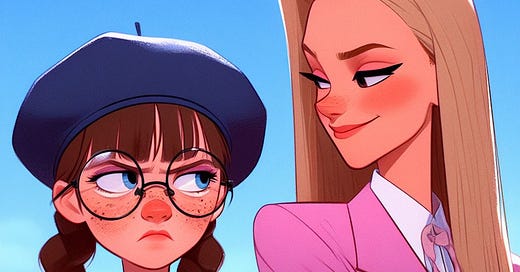


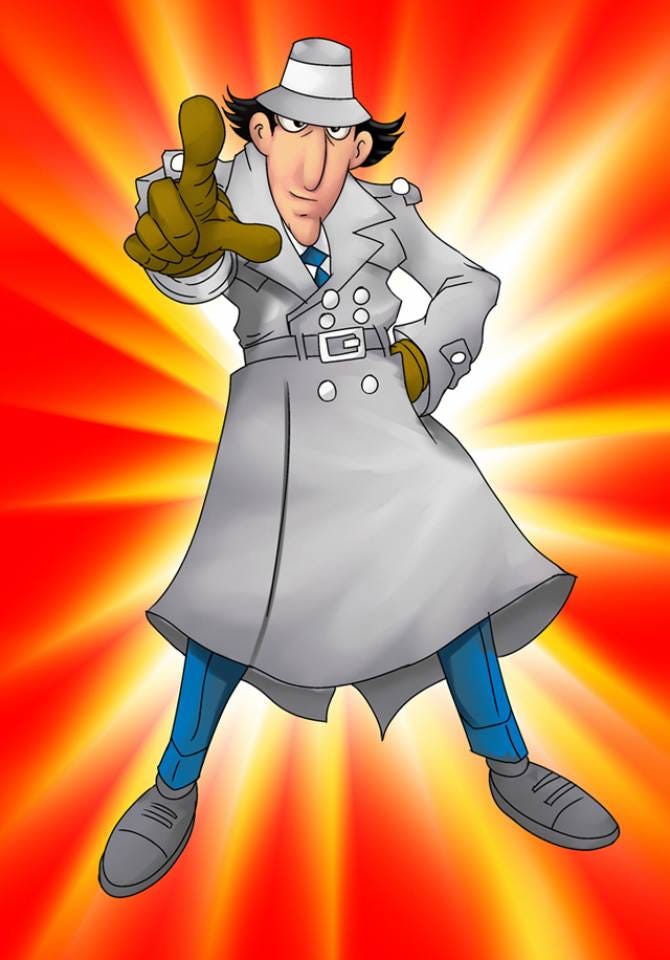
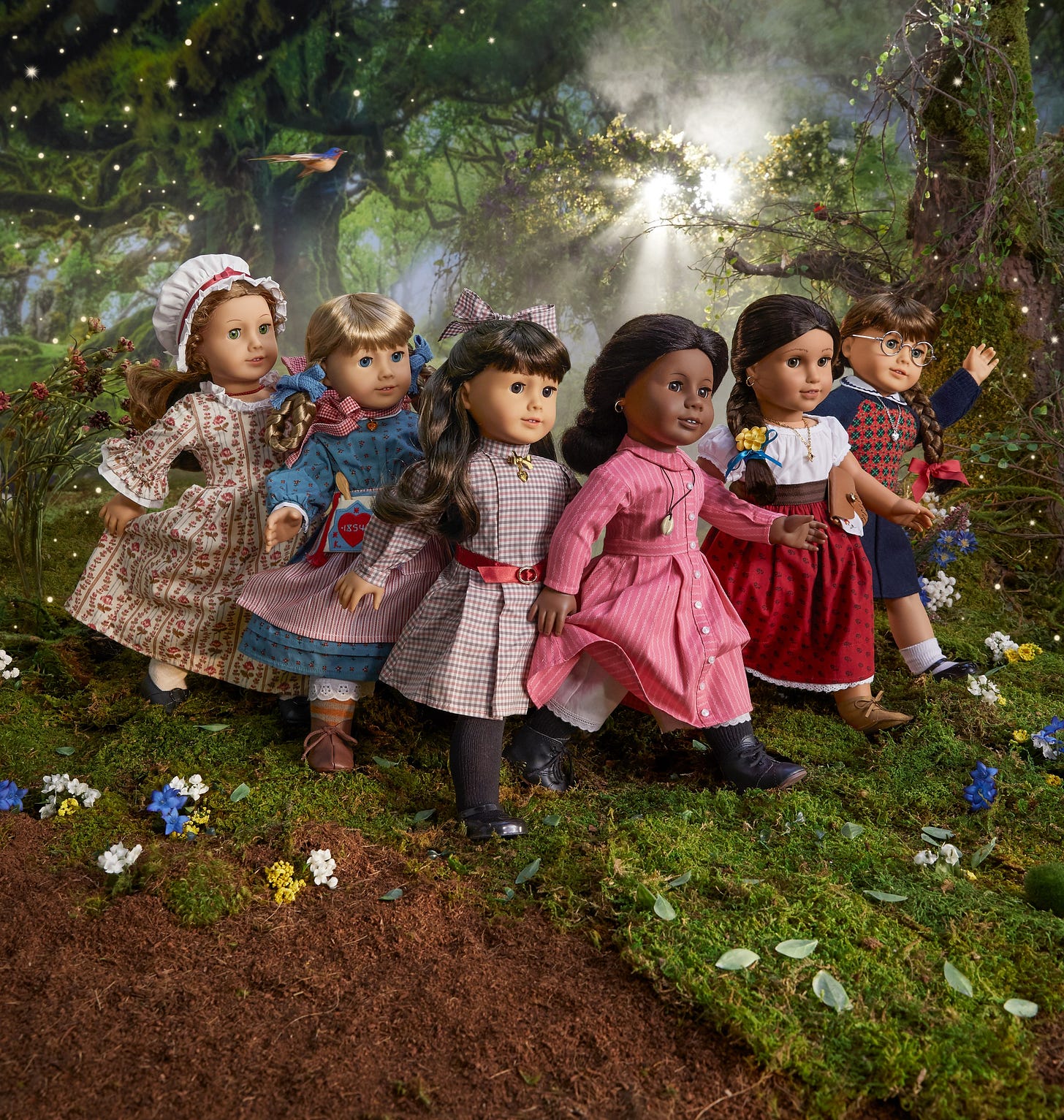


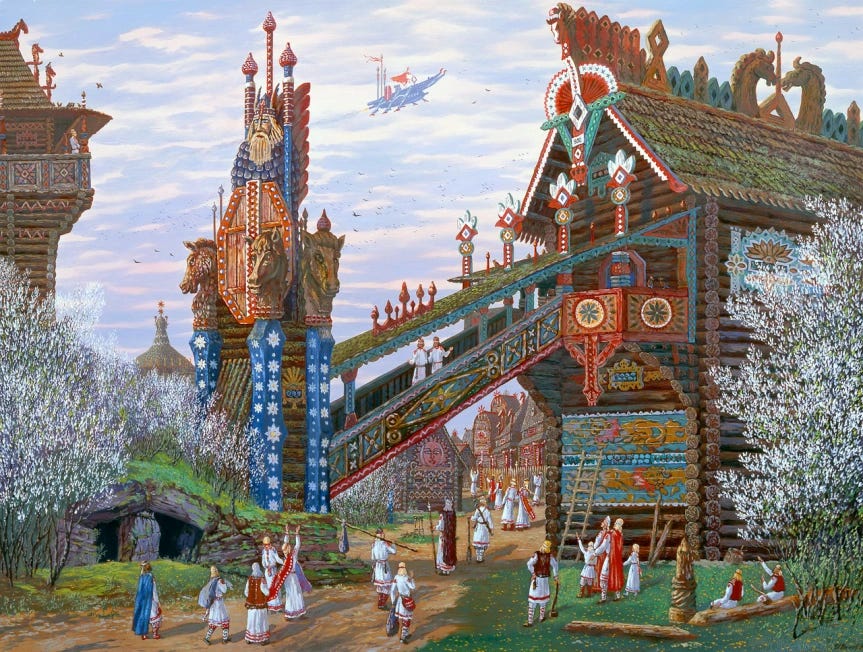
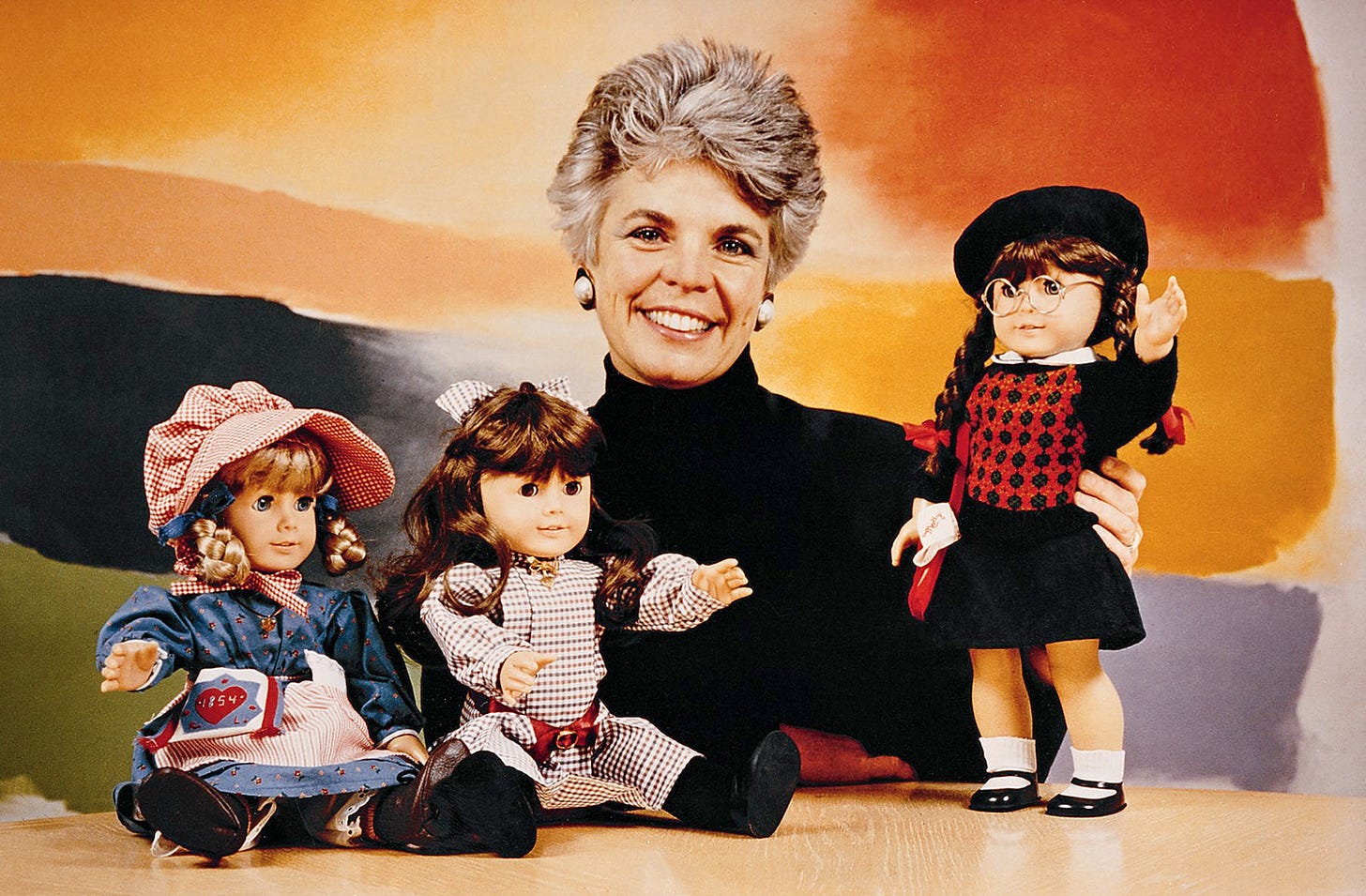
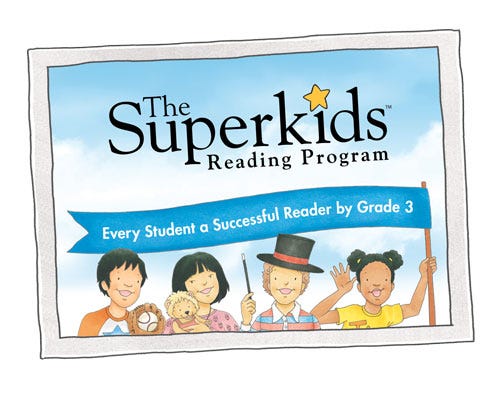
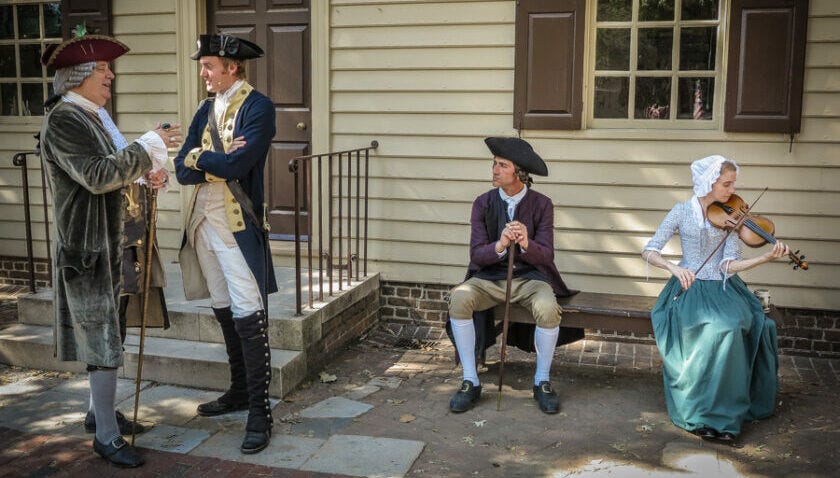
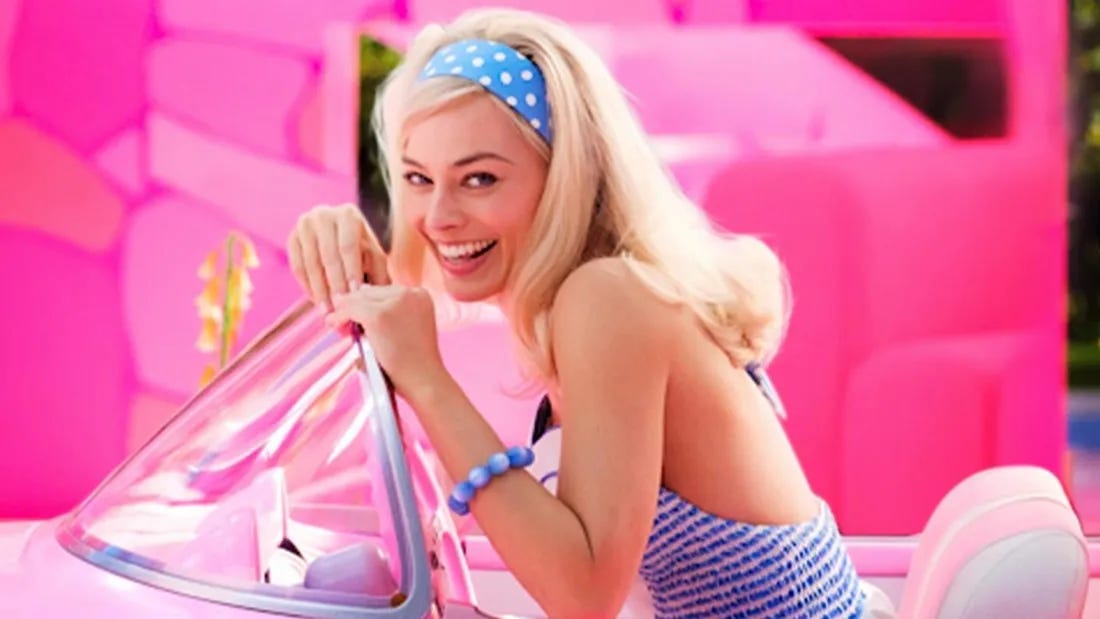
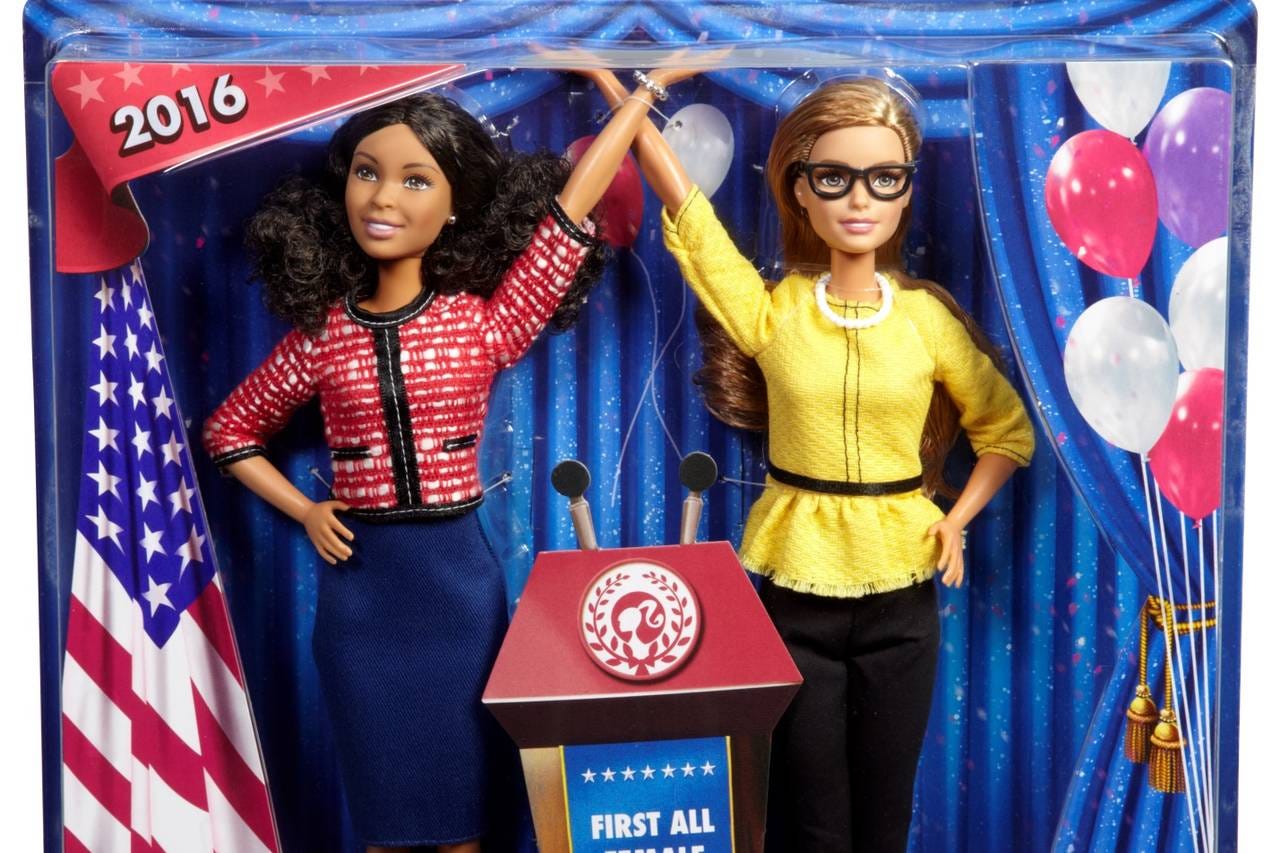
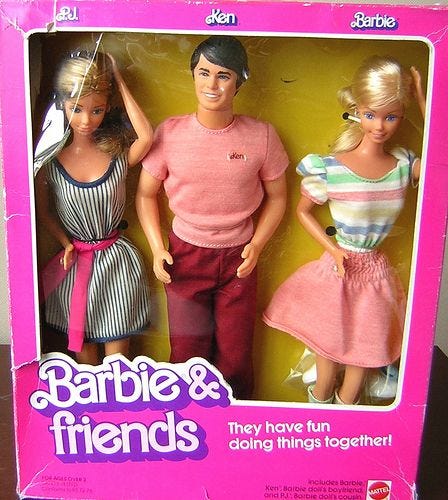
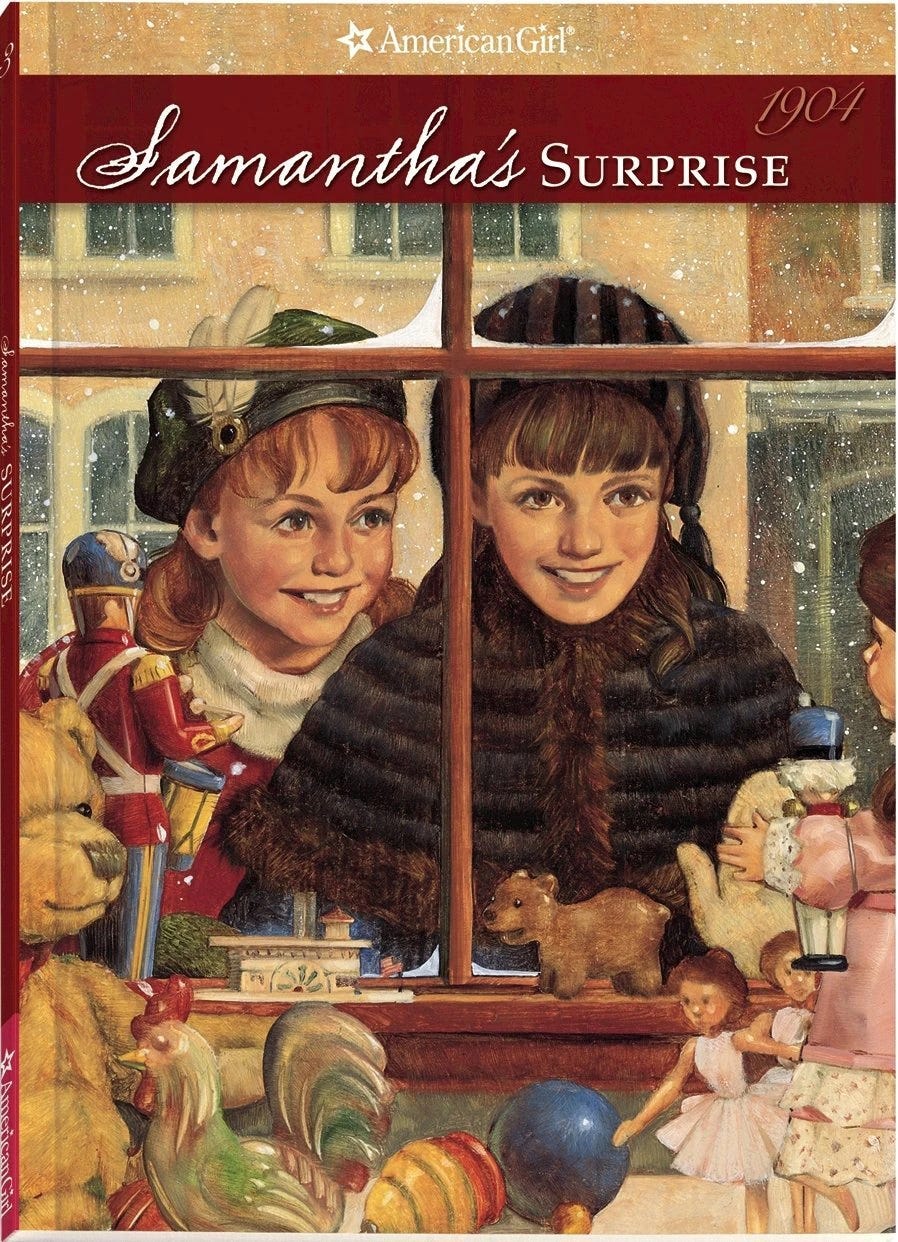
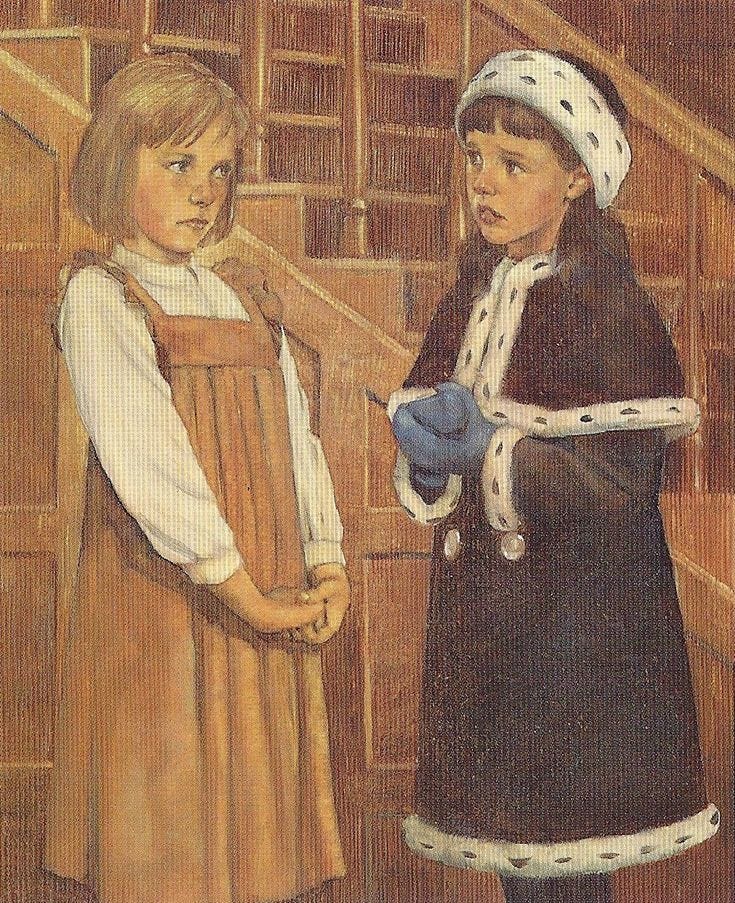
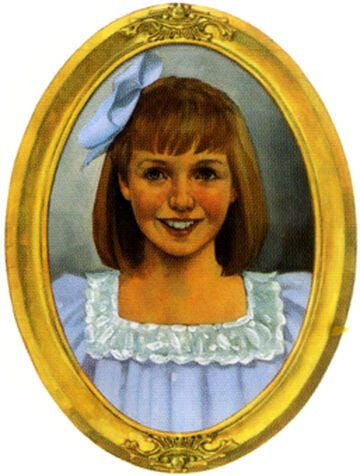
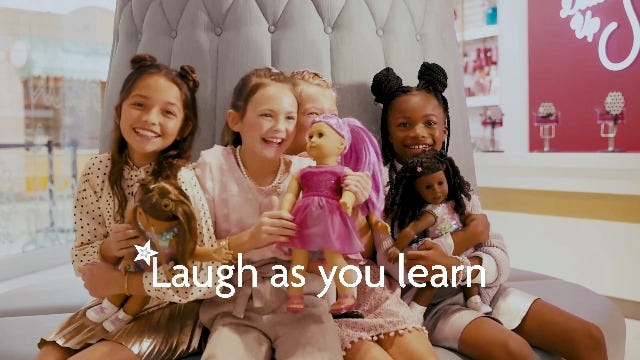
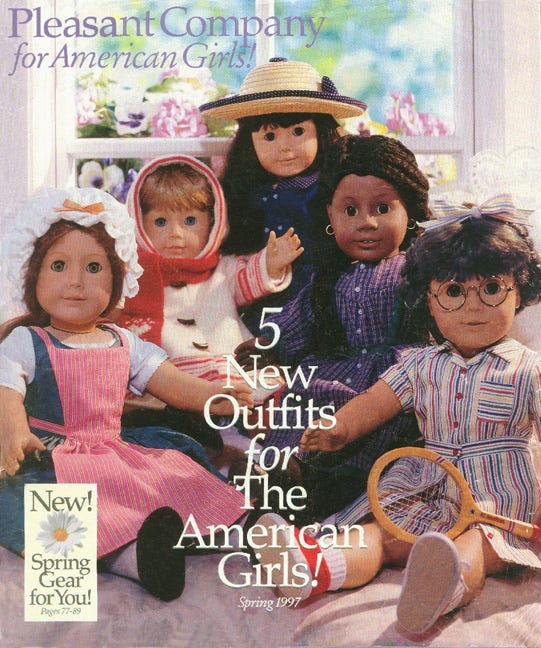
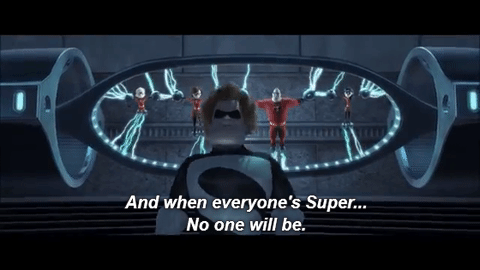
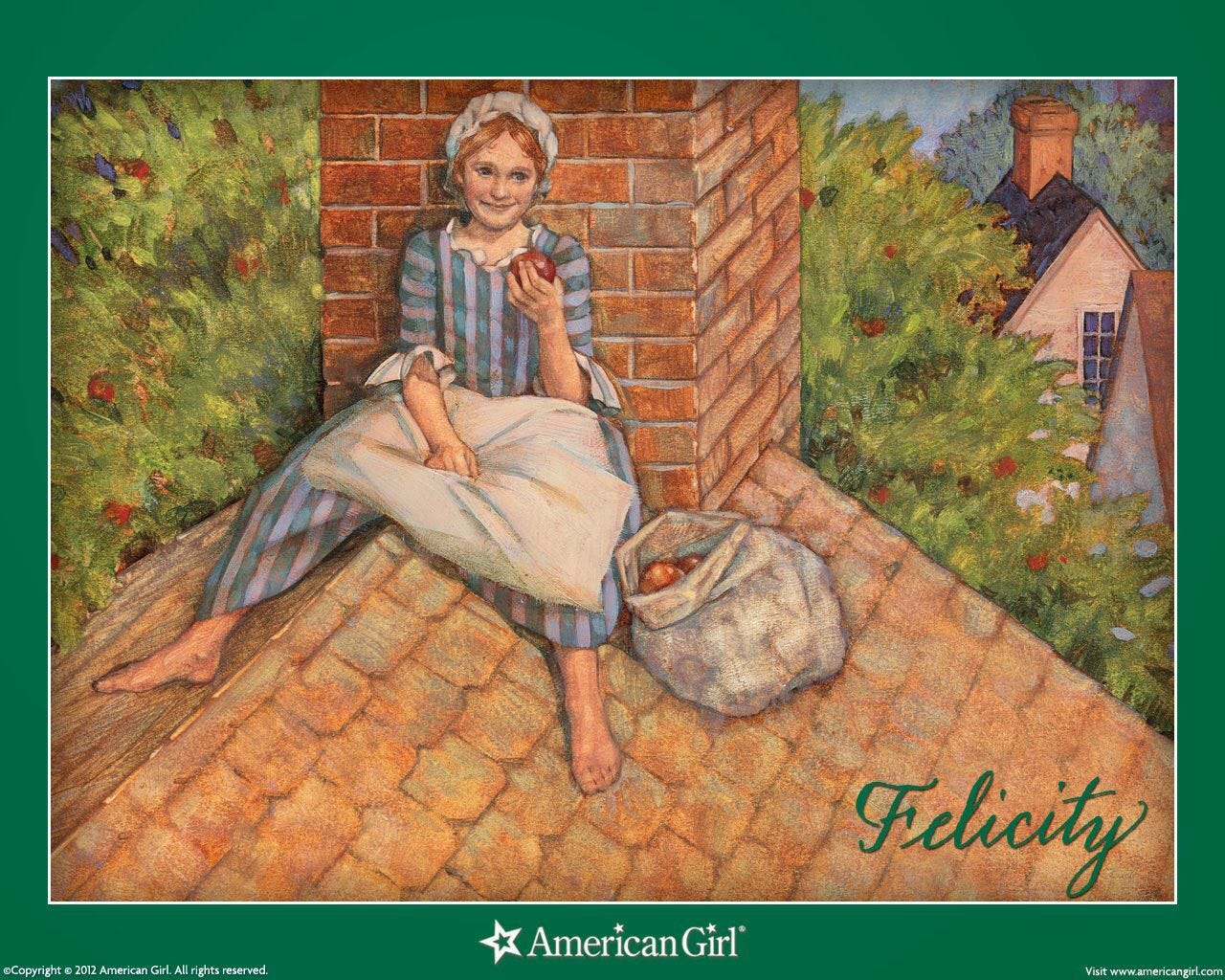

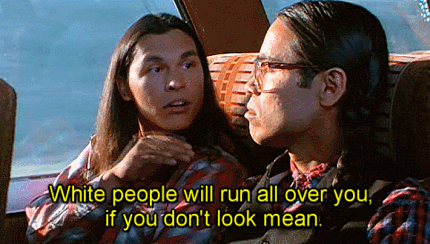

One other thing to mention is that Ms Pleasant, in her first cataloges - which I received! - was very explicit that the dolls were for girls age 8, no younger (the back of the catalog had baby dolls for any age). She said she felt this was a sort of magic age for girls, when they were old enough to care for their doll (absolutely just one, that was important) but not too old to play with their doll. And it is remarkably authentic, I would argue, and not cut-throat business at all, to say in her own catalog that she was selling to the few, not the many. I have a soft spot for Ms Pleasant.
So I had the catalog every year (it was an annual) for three years before I finally had the much anticipated birthday present of my very own Kerstin doll (being a Swedish immigrant myself), at last being 8. And every year after I would carefully budget and save to buy her kit and books myself, or I could ask for ONE thing for Christmas or birthdays. And it was the same for all my friends too. So... I think the dolls made us all better people, in a way.
It was all so well made, and I did take care of my doll. I still have all of it, put away in her convenient Swedish trunk, waiting for a granddaughter I guess as I didn't get any girls myself. And I totally would make the granddaughter wait until 8 too.
I was heartbroken to see the dolls ruined by Mattel, the mass production and so on. The first time I met someone with more than one, it was like meeting a pervert. Like, they didn't GET IT about the dolls.
Some years back, I had occasion to replace my then-girlfriend's teddy bear, which was eaten by our dog. It was just any old teddy bear, it was some special Blah-de-blah original model teddy bear.
Looking around for a replacement, I stumbled into the Stuffed Animal Internet. I felt the abyss open beneath me. I estimate that there are at least 10,000 people around the world for whom teddy bears and stuffed animals are -their entire lives.- Even more eerie than the teddy websites was the feeling that, just around the corner, there were doll websites run by people with abnormal interests.
I got the required replacement and got out, and never looked back.